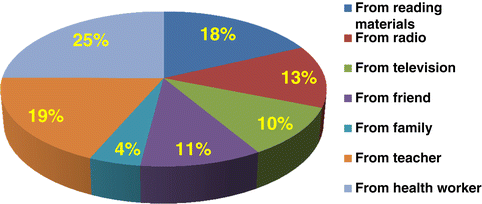Awareness of female students attending higher educational institutions toward legalization of safe abortion and associated factors, Harari Region, Eastern Ethiopia: a cross sectional study
- PMID: 25880854
- PMCID: PMC4383196
- DOI: 10.1186/s12978-015-0006-y
Awareness of female students attending higher educational institutions toward legalization of safe abortion and associated factors, Harari Region, Eastern Ethiopia: a cross sectional study
Abstract
Background: Unsafe abortion has been recognized as an important public health problem in the world. It accounts for 14% of all maternal deaths in sub-Saharan African countries. In Ethiopia, 32% of all maternal deaths are accounted to unsafe abortion. Taking the problem of unsafe abortion into consideration, the penal code of Ethiopia was amended in 2005, to permit safe abortion under a set of circumstances. However, lack of awareness on the revised penal code is a major barrier that hinders women to seek safe abortion. The aim of this study is to assess awareness of female students attending higher educational institutions toward legalization of safe abortion and associated factors in Harari region, eastern Ethiopia.
Methods: Institution-based descriptive cross sectional study was conducted among 762 female students who are attending five higher educational institutions in Harari Region. Systematic sampling method was used to identify study participants from randomly selected colleges. Self administered structured questionnaire was used to collect data. Data were entered in to Epi Info version 6.04 and analyzed by SPSS version 17.0 statistical packages. Frequency, percentage and ratio were used to describe variables. Multivariable logistic regression analysis was done to control confounders and odds ratio with 95% confidence interval was used to identify factors associated with awareness of female students to legalization of abortion.
Results: 762 study participants completed the survey questionnaire making the response rate 90.2%. Only 272 (35.7%) of the respondents reported that they have good awareness about legalization of safe abortion. Studying other fields than health and medicine [AOR 0.48; 95%CI (0.23, 0.85)], being the only child for their family [AOR 0.28; 95%CI (0.13, 0.86)], having no boy friend [AOR 0.34; 95%CI (0.12, 0.74)], using family planning [AOR 0.50; 95%CI (0.13 and 0.86)], being 25 years or older [AOR 1.64; 95%CI (1.33, 2.80)] were significantly associated with awareness of female students to legalization of safe abortion.
Conclusions: Only slightly more than a third of the study participants, 35.7% have good awareness of legalization of safe abortion. Strengthening information dissemination regarding legalization of safe abortion is required for female reproductive age group in general and higher institution female students in particular.
Figures
Similar articles
-
Knowledge and attitude of women towards the legalization of abortion in the selected town of Ethiopia: a cross sectional study.Reprod Health. 2018 Nov 21;15(1):190. doi: 10.1186/s12978-018-0634-0. Reprod Health. 2018. PMID: 30463567 Free PMC article.
-
Knowledge of reproductive and sexual rights among University students in Ethiopia: institution-based cross-sectional.BMC Int Health Hum Rights. 2013 Feb 13;13:12. doi: 10.1186/1472-698X-13-12. BMC Int Health Hum Rights. 2013. PMID: 23405855 Free PMC article.
-
Assessment of exposure to sexually explicit materials and factors associated with exposure among preparatory school youths in Hawassa City, Southern Ethiopia: a cross-sectional institution based survey.Reprod Health. 2015 Sep 14;12:86. doi: 10.1186/s12978-015-0068-x. Reprod Health. 2015. PMID: 26370668 Free PMC article.
-
Utilization and its factors of post abortion modern contraceptive in Ethiopia: a systematic review and meta-analysis.Reprod Health. 2021 Jul 3;18(1):143. doi: 10.1186/s12978-021-01195-8. Reprod Health. 2021. PMID: 34217317 Free PMC article.
-
Prevalence and Determinants of Early Initiation of Sexual Intercourse Among Youth Girls in Ethiopia.J Pediatr Nurs. 2020 Nov-Dec;55:e305-e312. doi: 10.1016/j.pedn.2020.06.008. Epub 2020 Jul 29. J Pediatr Nurs. 2020. PMID: 32736839 Review.
Cited by
-
Knowledge and attitude of women towards the legalization of abortion in the selected town of Ethiopia: a cross sectional study.Reprod Health. 2018 Nov 21;15(1):190. doi: 10.1186/s12978-018-0634-0. Reprod Health. 2018. PMID: 30463567 Free PMC article.
-
Necessary but not sufficient: a scoping review of legal accountability for sexual and reproductive health in low-income and middle-income countries.BMJ Glob Health. 2021 Jul;6(7):e006033. doi: 10.1136/bmjgh-2021-006033. BMJ Glob Health. 2021. PMID: 34321233 Free PMC article.
-
Safe abortion service utilization and associated factors among insecurely housed women who experienced abortion in southwest Ethiopia, 2021: A community-based cross-sectional study.PLoS One. 2022 Aug 18;17(8):e0272939. doi: 10.1371/journal.pone.0272939. eCollection 2022. PLoS One. 2022. PMID: 35980966 Free PMC article.
-
Assessment of knowledge on abortion law and factors affecting it among regular undergraduate female students of Ambo University, Oromia Region, Ethiopia, 2018: a cross sectional study.Contracept Reprod Med. 2020 Dec 1;5(1):37. doi: 10.1186/s40834-020-00136-3. Contracept Reprod Med. 2020. PMID: 33292767 Free PMC article.
-
Future health providers' willingness to provide abortion services following decriminalisation of abortion in Chile: a cross-sectional survey.BMJ Open. 2019 Oct 30;9(10):e030797. doi: 10.1136/bmjopen-2019-030797. BMJ Open. 2019. PMID: 31666266 Free PMC article.
References
-
- World Health Organization (WHO) Unsafe Abortion: Global and Regional Unsafe abortion: global and regional estimates of incidence of unsafe abortion and associated mortality in 2003. 5. Geneva: WHO; 2007.
-
- From concept to measurement: operationalizing WHO’s definition of unsafe abortion. 2014. Bull World Health Organ 2014;92:155. www.who.int/bulletin/volumes/92/3/14-136333.pdf - PMC - PubMed
Publication types
MeSH terms
LinkOut - more resources
Full Text Sources
Other Literature Sources
Medical



